Troubleshooting a spring no-start on a car with a mechanical fuel pump
So, your car ran in the fall. You take it out of storage after a winter snooze, and crank and crank and crank it, and it won’t start. What’s up? If it’s a carbureted car with a mechanical fuel pump, it may have a priming issue.
Nearly all fuel-injected cars have an electric fuel pump. The pumps on early injected cars switch on immediately when you crank the key to ignition. Later ones have a safety interlock that typically requires the presence of air flow into the engine so that they won’t continue to pump fuel if the car is in an accident. But in either case, electric pumps deliver gobs of fuel pressure almost immediately, which is one of the things that helps fuel-injected cars start even if they’ve been sitting for a long time.
In contrast, most carbureted cars have, or originally had, a mechanical fuel pump with a rubber diaphragm inside that’s moved in and out by a lever or a pushrod typically driven off the camshaft. There are several reasons why this often creates a situation where the car is difficult, sometimes impossible, to start after it’s been sitting all winter.
First, electric fuel pumps on fuel-injected cars can easily output 60 psi, often regulated down to 30-ish psi and then the excess fuel dumped back into the tank through a return line. That pressure pushes fuel very quickly. In contrast, the fuel pressure created by mechanical fuel pumps is much less, usually in the 1–4 psi range.
Second, this is important because the fuel system needs to be primed—the lines between the tank and the engine have to be filled with fuel. On a fuel-injected car with an electric fuel pump, this happens in mere seconds, but it’s different in a carbureted car with a mechanical pump whose fuel pressure depends on engine rpm. If there’s still fuel in the float bowl, you can mash the accelerator pedal a few times, and on a carburetor with an accelerator pump, it’ll squirt gas from the float bowl down into the throat of the carb. That’ll help the engine to start, and once it’s running, the higher rpm will make the fuel pump run faster, making it easier for it to prime the system. But if the car’s been sitting long enough that the fuel in the float bowl has evaporated, the fuel pump will need to fill it. So you can get into bootstrapping issue where, when the engine is being cranked off the starter, it’s spinning only a fraction as fast as it is when its running, and combined with a weak battery, an old starter, an original mechanical fuel pump in which the rubber diaphragm has gotten old and lost some of its elasticity, it may have trouble priming.
The third issue is that, in addition to the pressure differences between mechanical and electric fuel pumps, they work in different ways. Mechanical fuel pumps suck fuel by creating an oscillating vacuum on the inlet side. In contrast, electric fuel pumps, at least the rotary ones, create a fairly constant fuel pressure, and while they obviously have to draw fuel from the tank, they push more than they suck. This is why mechanical fuel pumps are mounted on the engine whereas electric fuel pumps are mounted at the rear of the car, often in the gas tank itself.
Lastly is the issue of vacuum leaks in the fuel lines. As rubber fuel hose gets old, it dries out, and it’s possible for air to be drawn through the sides. On the vintage BMWs I own, there’s a short section of rubber fuel line in the trunk that connects the pick-up tube in the task tank to the metal or plastic line that runs the length of the car. That line is under a screwed-down trunk panel, so it’s common to find that it’s the original 47-year-old piece and it’s become dry-rotted. If the car ran last winter but won’t fill the float bowl in the spring, this is a prime culprit. If it’s original, replace it. Be certain the hose clamps are tight. If the fuel line is plastic, check the end of it thoroughly for cracks and splits.
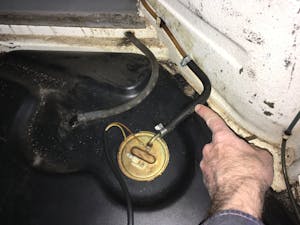
Of course, it’s possible that the mechanical fuel pump really has died—that the rubber diaphragm has cracked or torn, or that the little check valve inside is stuck open. So how to you test it?
Obviously, first make sure that the problem actually is fuel and not spark. Take the center wire out of the distributor and hold it with rubber gloves or insulated pliers one-quarter inch from a good ground while someone cranks the engine. If you see spark, good. Then, if you like, you can hold open the throttle, give a good blast of starting fluid, and try to start the car. If it runs for a few seconds, then dies, you definitely have a fuel delivery problem.
If you have a low-pressure electric fuel pump, or even a pump bulb (like for a small gas boat engine), you can temporarily splice it in and fill up the float bowl. If it won’t fill, then you have some other problem like a fuel line obstruction or a clogged fuel filter. If once the float bowl is full, the car still won’t start and run, you have some other problem in the carb such as plugged jets or accelerator pump nozzle. The irony, though, is that if you prime the system and the car then starts and runs, you’ve made it harder to find the root cause of the inability for the system to prime itself.
Here’s what I do to test the mechanical fuel pump directly:
Undo the gas lines from the fuel pump and unbolt the pump from the engine. A lever of some sort will be located at the base. The one on my Lotus Europa protrudes by several inches and directly contacts the camshaft, but others may use an intermediate pushrod and have a much smaller lever mechanism. It may look like a little lever or it may be a spring around a plunger. It may be recessed inside the base or it may protrude. If it is recessed, use a wooden or plastic probe to move it. If it’s exposed, you can just push the fuel pump down on it on a block of wood. Listen for a sound vaguely like inhaling and exhaling out of pursed lips. If you hear nothing, the diaphragm could be torn, and the pump is likely bad.
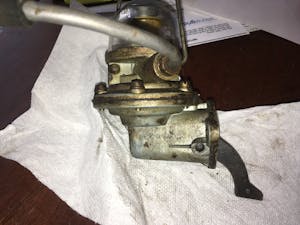
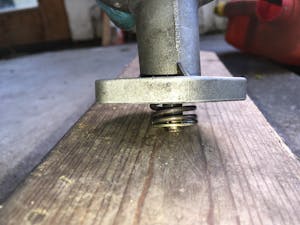
If the pump passes that test, repeat it while putting a finger on both the inlet and outlet fittings. You should feel suction on the former and pressure on the latter. If you don’t, the check valve inside the pump could be stuck open.
Next, test that the pump actually moves liquid. You can do this with water, but because of concern over getting water into the float bowl, I do it with gas (be sure to have a fire extinguisher at the ready). Put a short length of rubber gas line (that you’re certain isn’t porous) on the inlet and outlet sides of the pump. Put the inlet hose into a container of liquid and the outlet hose into a catch container. Work the lever of the pump back and forth. It usually doesn’t take much effort to move liquid and convince yourself that either the fuel pump actually pumps fuel or it’s dead. If it is dead, whether it’s rebuildable or worth rebuilding varies greatly model to model. Sometimes the diaphragm can be easily replaced, but other pumps have permanently crimped top and bottom sections. As with many vintage car parts, if originality is important to you, there are specialty shops that rebuild fuel pumps.
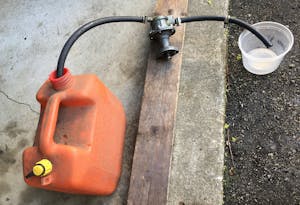
If the pump seems healthy, repeat the test with it installed on the engine. That is, mount the pump back onto the engine but continue to feed it gas or water via a hose into a source container, and the output sent into a catch container. It’s easiest to do this with a helper who cranks the engine, or to use a remote start switch hooked to the starter. Be certain to disconnect the wire from the “+” or “15” side of the coil so the engine won’t try to start. If you like, you can remove the spark plugs to make the starter spin faster. If no liquid pumps when the pump is attached but it did when it was tested alone, you may still have an air leak you haven’t found. If not, the difference could be that loss of elasticity in the diaphragm, or in extreme cases, wear in the pump rod/lever—or even the lobe of the camshaft—has tipped it over the edge to non-functionality.
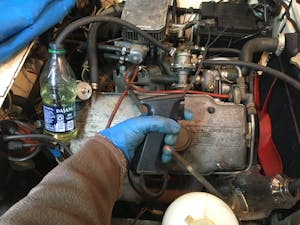
But if it does pump fuel from a small container, re-install one connection at a time. Try the inlet side—the connection to the fuel tank—first. If it doesn’t pump, trace it down. You’ll likely find a porous rubber gas hose, or a cracked plastic one. Then reconnect the output side. It’s possible that the needle valve in the float bowl is stuck closed.
So, with all that, I can tell my mechanical fuel pump story. I just went through everything above on my 48,000-mile 1973 BMW 2002. It had a hard time starting when I bought it last fall, but that wasn’t surprising since it had sat for a decade. I primed it with an electric fuel pump, and the problem largely went away; after that it started and drove fine. But when I roused it from its winter snooze, I faced the same problem and wanted to solve it once and for all. I went through the above steps, found that the mechanical fuel pump worked fine both in standalone testing and when reattached to the engine and fed gas from a can, but didn’t work when the gas lines were hooked back up to it. There was a fuel filter on the inlet side of the pump, as there usually is on a BMW 2002. I removed both hoses and the filter and replaced them with a single brand-new section of fuel hose run directly from the plastic fuel pipe coming through the firewall to the fuel pump inlet, and it pumped fine.
What was going on?
The problem was the fuel filter.
No, it wasn’t clogged. No, it wasn’t leaking.
The cause appears to be that mechanical fuel pumps aren’t really designed to have filters on the inlet side—screens, yes, but not canister filters with any substantial volume to them. I would’ve sworn that this was the stock location for a BMW 2002 fuel filter, but on digging into it, I learned that these cars have a screen at the bottom of the pickup tube in the trunk, and a second one inside the fuel pump, but that, when delivered new, had no external fuel filter. They were added by repair shops and DIYers and became so ubiquitous that I and most other folks assume they’re original.
There’s the school of thought (which I always followed), that the filter should go before the fuel pump because that way it keeps rust and sediment from the gas tank out of the pump. The other argument, by the way, for having the filter on the inlet side of the fuel pump is that if the filter splits or leaks, the pump will just suck air and fuel flow will stop, whereas if it’s on the outlet side, fuel will continue to be pumped into it and it’ll leak in the engine compartment. While I don’t discount either of these arguments, it turns out that, with a mechanical fuel pump, having the filter on the inlet side can be problem because, if it’s not full of fuel, the fuel filter housing then holds a pocket of air that the oscillating pressure of the fuel pump can’t suck out. As I said above, combine this with an old fuel pump and a weak starter motor and it can be enough that the system won’t prime. This appeared to be the case with my car. Fuel filter on inlet side of pump = no prime. No fuel filter at all or filter on outlet side of pump = prime and start.
For years, when resurrecting long-dead cars with rusty gas tanks, I’ve cleaned the gas tank by throwing a chain into it and shaking the tank, reaching into it (if I can) and scrubbing it with a Scotch-Brite pad, then splicing a canister filter into the gas line in the trunk to catch any residual rust and sediment before it gets into the electric fuel pump and ruins it. However, I now realize that this has been on fuel-injected cars, whose rear-mounted high-pressure electric fuel pumps aren’t as likely to have the priming issue described above.
I’m not saying that every fuel filter mounted in front of a mechanical fuel pump will cause problems. I’m just saying that, if you’re experiencing a priming issue, add it to the list of possibilities.
Go and find your prime suspect.
***
Rob Siegel has been writing the column The Hack Mechanic™ for BMW CCA Roundel magazine for 34 years and is the author of five automotive books. His new book, Resurrecting Bertha: Buying back our wedding car after 26 years in storage, is available on Amazon, as are his other books, like Ran When Parked. You can order personally inscribed copies here.

